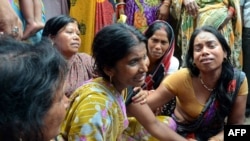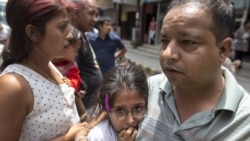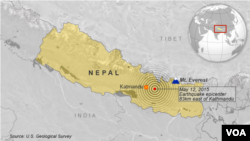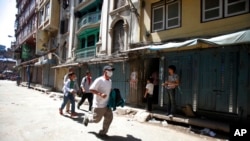A strong earthquake struck Nepal early Tuesday afternoon, killing at least 41 people, in a country still dealing with a devastating quake that hit less than three weeks ago..
An official with Nepal's home ministry also reported more than 1,100 people injured.
The U.S. Geological Survey said the 7.3-magnitude quake was centered about 80 kilometers (50 miles) east of the capital, Kathmandu in an isolated area close to Mount Everest and Nepal’s border with Tibet.
An American Marine helicopter was declared missing while participating in humanitarian assistance and disaster relief operations near the town of Charikot. Army Maj. Dave Eastburn, Spokesman for US Pacific Command described the missing aircraft as a UH-1Y Huey with Marine Light Attack Helicopter Squadron 469 in support of Joint Task Force 505. Eastburn said that JTF 505 personnel are responding to the emergency and that the incident is currently under investigation.
Six strong aftershocks were reported shortly after the quake with tremors being felt in India, where at least four were killed, and Tibet, where one death was reported.
Sudarshan Shrestha of the international aid group Save The Children told VOA he was inside a hospital in Kathmandu at the time of the earthquake, and that while that building did not seem to be damaged he later saw others nearby that collapsed.
'Chaos and pandemonium'
"What we saw was chaos and pandemonium with all the patients inside the building running out, and maybe 300 to 350 patients inside the building running out," he said.
Shrestha said Save The Children's resources were already stretched after the April 25 earthquake that killed more than 8,000 people and left thousands homeless, including some in villages the group had not yet reached.
The new disaster and impending rainy season will only make their work harder.
"It's going to be difficult to get back on our feet just in terms of responding to relief needs as the monsoon is away in just about four weeks or five weeks time, so we really have to think hard about how we respond to the needs of the people," he said.
Mountaineers seeking to scale the world's tallest peak have called off this year's Everest season after 18 people died when last month's quake triggered avalanches on the mountain.
Dambar Parajuli, president of Expedition Operators' Association of Nepal, said there were no climbers or Nepali sherpa guides at the Base Camp.
Dove under tables
UNICEF's Rose Foley, who was in Kathmandu at the time of the earthquake, said the agency's staff dove under tables as its building shook side to side and later made it outside.
"Sitting out in the open it felt like I was on a boat on rough seas as aftershocks hit," she said, adding the U.N. is concerned about the effect on children, who were already in need following the April 25 earthquake.
The epicenter Tuesday was about 100 kilometers (62 miles) from the center of last month's quake.
The government and aid agencies have been working to provide food, water and shelter in an operation that struggled in its early days because of aftershocks, bad weather and the challenge of reaching outlying areas in the Himalayan nation.
Last week, the United Nations said it had received only $22 million of the $415 million needed for the emergency response to April's earthquake.
Jamie McGoldrick, the U.N.'s chief official in Nepal, said donations for the humanitarian efforts in the impoverished Himalayan nation need to be "dramatically ramped up."
McGoldrick said relief personnel are now working "so that people have roofs over their heads and their other urgent needs are addressed before the monsoon season starts."
Monsoon rains usually start in June, triggering avalanches and flooding.
Hub for aid
The quake Tuesday caused landslides around Chautara, and more than 100 people had been injured in surrounding villages, chief district officer Krishna Gyawali told The Associated Press.
Paul Dillon, a spokesman for the International Organization for Migration (IOM), said a rescue team from the agency has begun searching through the wreckage at Chautara, which was heavily damaged in April's earthquake.
Chautara had become a hub for humanitarian aid in the wake of the earlier quake.
Tuesday's quake was deeper, however, coming from a depth of 18.5 kilometers (11.5 miles) versus the April 25 quake that hit 15 kilometers (9.3 miles). More shallow earthquakes tend to cause more damage at the surface.
In Kathmandu, the international airport, which has become a transport hub for international aid, was closed temporarily. Traffic snarled in the streets. The city lost power. Shops that had just reopened after last month's quake quickly closed. Telephone circuits were inundated. Television footage showed Nepal’s parliament shake as the quake struck.
The quake also sent people rushing outside their homes, where many remained hours later.
'A lot of confusion'
Aid worker Mulchand Dedhia said, “I think there is still a lot of confusion, people still are actually in a dilemma on what to do next. I think they are still going to be waiting here trying to figure out the next step. I am pretty sure people here are pretty shaken, so I don’t think they will be venturing anywhere inside at least for some more time.”
Officials gave no immediate estimates of damage.
Strong shaking was also felt across northern India and Bangladesh. In the Indian capital of New Delhi, thousands of workers ran out of high rise buildings that were swaying.
L.S. Rathore, head of the India Meteorological Department, said this quake was deeper than the one that struck in April. Deeper quakes generally cause less destruction, but Rathore said Tuesday’s jolt had the potential to cause damage, because structures that have were weakened by the previous earthquake could become even more vulnerable after the latest one.
Across the Nepalese border in Tibet's Jilong and Zhangmu regions, the Earth shook strongly. Tremors were also felt slightly in the Tibetan capital, Lhasa.
Carla Babb contributed to this report from the Pentagon. Some material for this report came from AP and Reuters.








